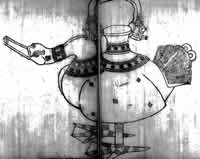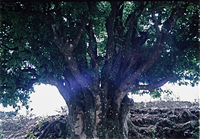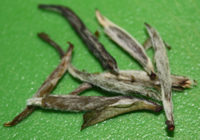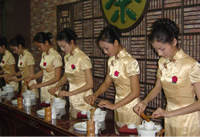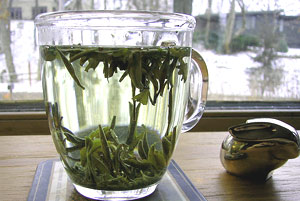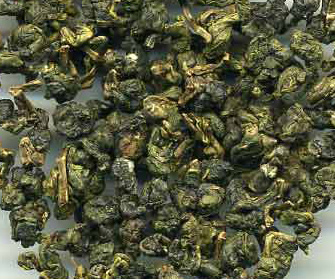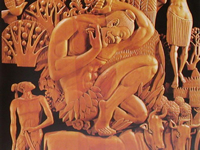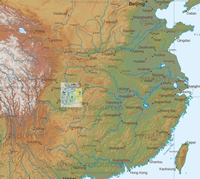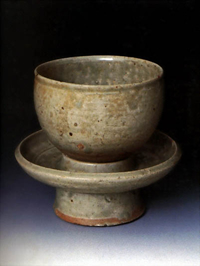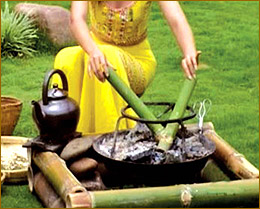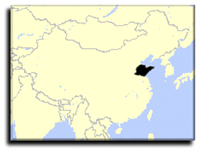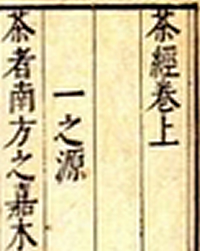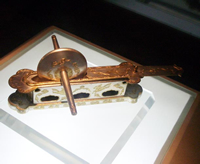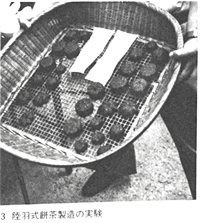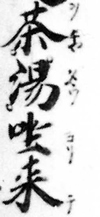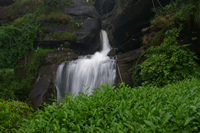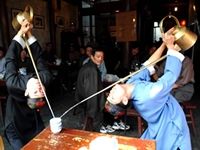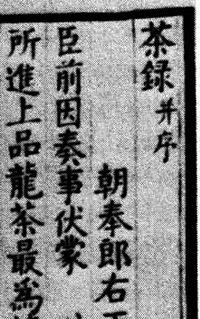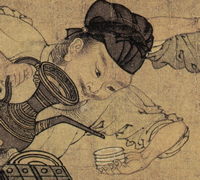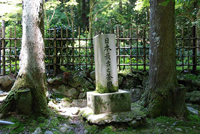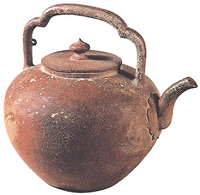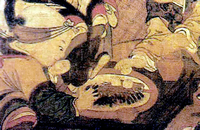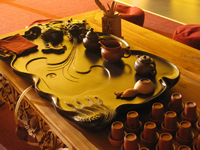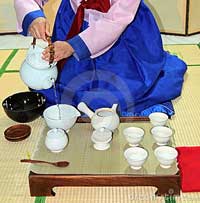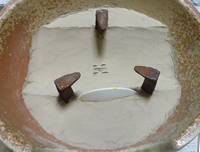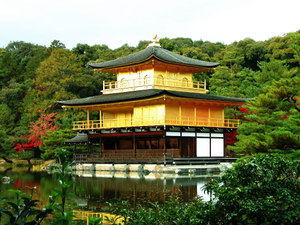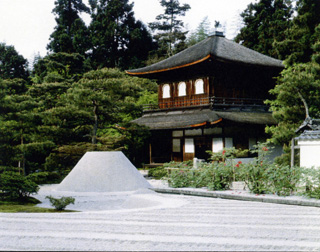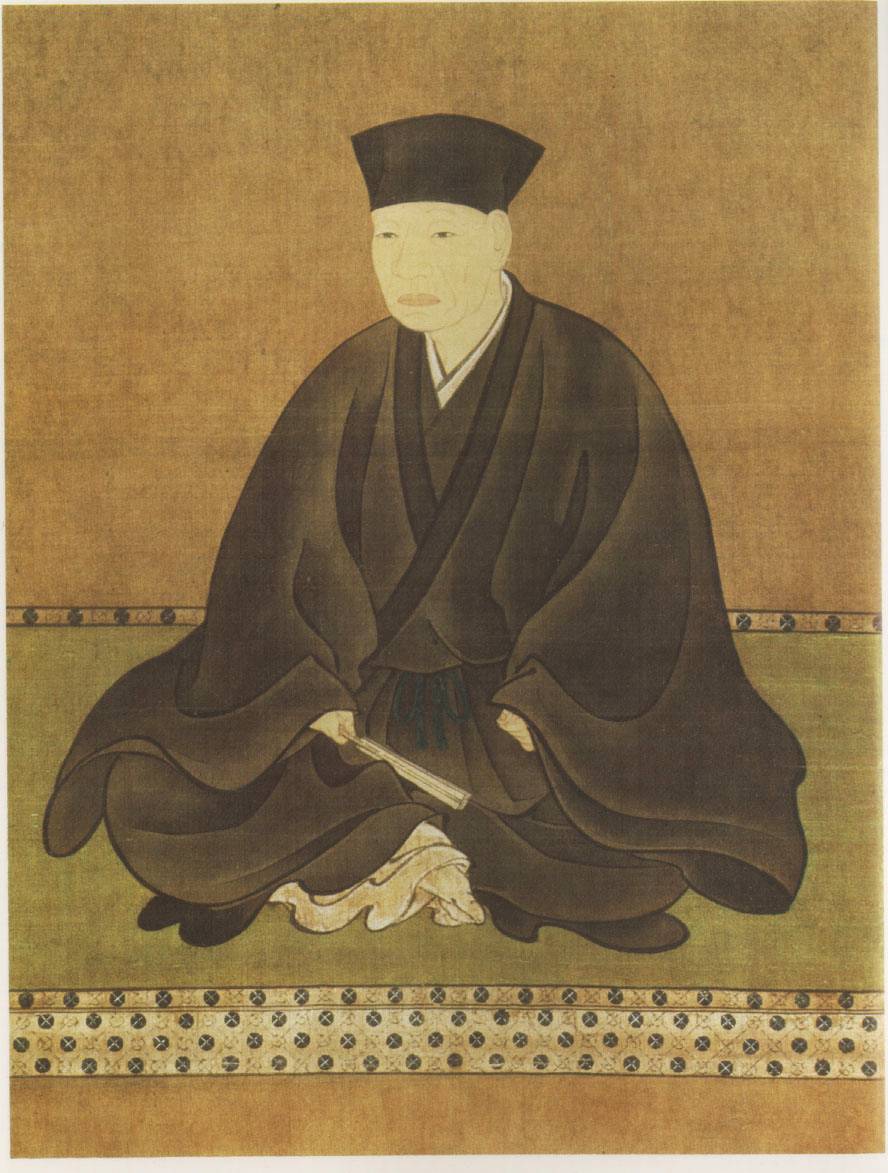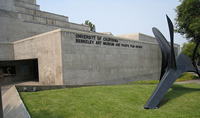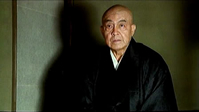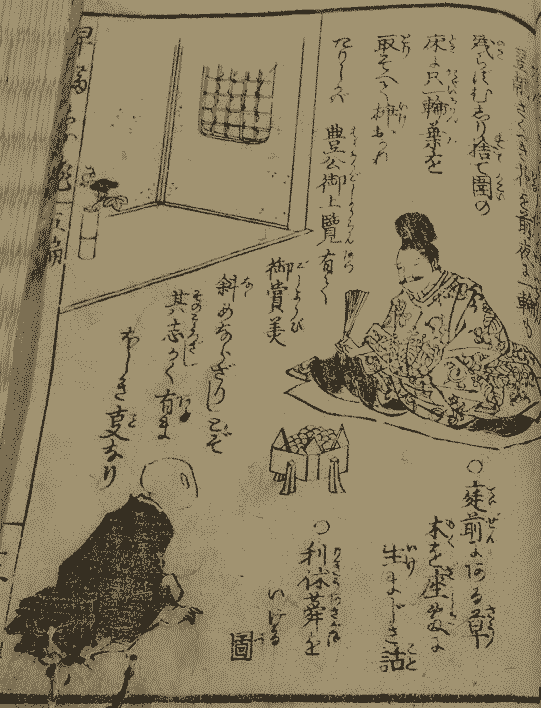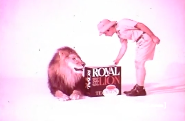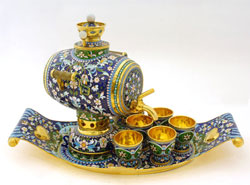Tea Identification Day(s)
Tea Identification Day(s) — this is a separate assignment than "Tea Profiling Day" and is unrelated to it
(NOTE: If you do not usually own tea, or just happen to have run out of tea, or just don't like sharing tea, this exercise does NOT require that you submit tea to the class, but I hope that you can.)
Early in the term, after we have discussed the physical attributes of the tea plant and brewed tea, students bring to class samples of tea that we then try to identify. I lay out the teas on tables, in coded ziplock bags, and student tea groups go from table to table, completing an answer sheet as they try to guess the details of the teas inside the bags. Although a good nose is probably your best weapon for this exercise, I have strewn clues across these several sessions, and the look of the leaf is your next best technique, so some Web searching of basic tea types (and your notes from tea brewing day) might be helpful. This is an ungraded assignment except that I do expect attendance on one of the two identification days (schedule provided elsewhere).
Timeline:
- Two class sessions before the tea flaor profiling day (three sessions before the first "tea identification day"):
- Required: We form groups. You will make a team, designate a team leader, and give me an index card with the details.
- One class session before the first tea identification day (this probably means exactly on the tea profiling day):
- Submit your tea in a ziplock bag day. (See instructions, below. *Please note that although some will bring tea on this tea profiling day, this tea is for drinking on that day and has nothing to do with this separate exercise of tea identification.)
- "Tea Identification Day, First day": Required on this day—attendance if your group has been assigned this day.
- "Tea Identification Day, Second day": Required on this day—attendance if your group has been assigned this day.
Instructions for submitting tea:
- Submission of tea is optional. We don't need 50 bags of tea, but it would be nice to have 25. Extra credit for bringing tea, whether used for the exercise or not. (When there is a tea overflow, I select an appropriate number of bags.)
- How much to bring. Please bring the amount of tea that you would use to make one or, better, two "cups" of tea.
- How to bring the tea. Please place your tea inside a sealable but openable and clear small plastic bag. We open and smell. (If your tea is very strong in smell, please double bag it. The smell penetrates the bags of other teas and makes them hard to identify.) Label it like this: your initials + a three digit number. I'm John R Wallace, so I might code my bag as "JRW276" (the number is random). This method should prevent two of you from accidentally having the same ID on your bag. If you do not want your tea given away at the end of the exercise or do not want it opened and sniffed / touched, place a large "X" on the bag somewhere. I will return it to you. Bags with "X" on them cannot be opened by anyone.
- Information sent separately. Download from bSpace the excel sheet titled EA109Fa13 LASTNAME classname IDTEA, complete it, and email it to me (using the regular subject line plus the keyword TEAID) by the requested time (see Important Dates & Deadlines for the due date). The excel sheet asks for this information:
- the ID number on the bag you submitted (plus an "X" if you want the tea no to be opened, and later returned to you)
- the place of origin (country, province, further details if known) — do not submit tea if do you not know its country of origin
- type of tea (Use the Chinese terms exactly as we have them on the Chinese terms web page, from the row labeled "literal meaning". Do not submit a tea if you feel you can't get an accurate statement on this aspect, although some variation is typical. Call pu-er, by the way, red/black unless you know for a fact that is was a green tea that was then fermented.)
- and, if it has a neat history, share that please — "bought this from a shop in Shanghai this summer" etc.
Identifying the coded teas and reporting your guesses. On tea identification day, the group receives answer sheets (one for each person in the group plus an additional one sheet). The leader gets the sheets from me. Groups move from table to table according to my time control (which is usually about 4 minutes per table) while taking notes. After they have seen all the teas, the group consults, making guesses about the tea. The group leader is responsible to give to me, at the end of class, all of the individual answer sheets and the one group answer sheet that has the official decisions of the group.
Special note: You can bring more than one type of tea, but please don't bring more than three. I will be selecting which teas to put out for identification. (Generally this means reducing the number of duplicates but poorly labeled tea and such can cause elimination.)
Special note: Please try extra hard to be in class on time or a bit early. Set up for this exercise is complicated. Sit with your group.
Special note: If you intend to use tea bags, please cut the bag and bring only the loose tea. I prefer that you do not use tea bags since most tea bag content is tea leaves cut into fine pieces. It becomes hard to guess the tea. Still, not all tea bags are like this and some aromatic teas and such could work, too.
Special note: In theory we are identifying camellia sinensis (or assamica) leaves. However, you are welcome to bring blended tea or other, non-camellia leaves used to make "tea" and try that way to trip up other groups. No illegal substances please!
Midterm 01
Test content
We are studying, at a detailed level, how tea culture was shaped and moved. Prioritize your data management using that principle. Successful prioritizing requires a good understanding of the conceptual thrust of the course, and part of the exam is checking how well you understand those concepts. That being said, the icon below on PowerPoints identifies specific slides or even sections of specific slide as testable.

That should help give a sense of both the level of detail and the type of information I think is target information. The tea basics segment of this course is not forgotten but the vast number of questions are from the lectures after we wrapped up the tea basics portion of the course. The last lecture before the midterm, on Heian Japan, is definitely part of the exam.
Test style
This is a closed-book exam, with a seating chart.
There are prompts for which you need to write key information. The prompts are in the shape of pictures, poems, names of individuals, descriptions of an individual's actions, maps and so forth. You will write very brief descriptions of the prompts (less than a sentence).
There are several very short essay questions. They might be analytic or they might be the types of questions a random person might ask you about tea culture.
On test day
- Memorize the last four digits of your SID ahead of time.
- Arrive on time. You need every minute for the essay questions. Since there is a seating chart, and since the room is often crowded beforehand, be ready to sit down quickly in your correct location.
- Make restroom stops ahead of time. You cannot leave the room during the exam. If you do need to leave the room, give me your exam. I will grade the portion you have completed. You cannot reenter the room.
- You may write with pen or pencil. You may have whiteout or erasers but pen holders will need to be put away.
- You do not need paper or anything else. I will project time at the front of the room.
- If you look at another student's answer sheet during the exam, you will receive an "F" for the exam.
Preparation
Good familiarity with the key information is very helpful since you will not have much time to think. For the essays you need to think deductively, drawing on a variety of sources for your answers. I will be watching carefully if you understand the essentials, not whether you can roll out a lot of facts but don't seem to understand the significance of those facts. On-point, brief answers grounded in course information should be your goal.
Grading rubric
Actually, I decide this post-exam after I have done an initial grading. In princple the information check section and the essay section are of equal weight. There are no extra credit questions. Spelling should be good but does not need to be perfect. You must write in English. I understand that I am "spot checking" your knowledge of the details of the course and that there are a lot of details. Thus, the usual conversion scale for the information check section settles on the bottom of the "A" backet at around the 80% mark, usually.
Midterm 02
Fall 2013: Midterm 02 is almost exactly like Midterm 01. I have highlighted with green below when I have added or changed comments that were under Midterm 01
Test content
We are studying, at a detailed level, how tea culture was shaped and moved. Prioritize your data management using that principle. Successful prioritizing requires a good understanding of the conceptual thrust of the course, and part of the exam is checking how well you understand those concepts. That being said, the icon below on PowerPoints identifies specific slides or even sections of specific slide as testable. In addition, on lecture notes you will see some items with sidebars or in bold. That is where the focus should be.

That should help give a sense of both the level of detail and the type of information I think is target information. The last lecture before the midterm, on Korea, is definitely part of the exam.
Test style
This is a closed-book exam, with a seating chart.
There are prompts for which you need to write key information. The prompts are in the shape of pictures, poems, names of individuals, descriptions of an individual's actions, maps and so forth. You will write very brief descriptions of the prompts (less than a sentence).
There are several very short essay questions. They might be analytic or they might be the types of questions a random person might ask you about tea culture.
On test day
- Memorize the last four digits of your SID ahead of time.
- Arrive on time. You need every minute for the essay questions. Since there is a seating chart, and since the room is often crowded beforehand, be ready to sit down quickly in your correct location.
- Make restroom stops ahead of time. You cannot leave the room during the exam. If you do need to leave the room, give me your exam. I will grade the portion you have completed. You cannot reenter the room.
- You may write with pen or pencil. You may have whiteout or erasers but pen holders will need to be put away.
- You do not need paper or anything else. I will project time at the front of the room.
- If you look at another student's answer sheet during the exam, you will receive an "F" for the exam.
Preparation
Good familiarity with the key information is very helpful since you will not have much time to think. For the essays you need to think deductively, drawing on a variety of sources for your answers. I will be watching carefully if you understand the essentials, not whether you can roll out a lot of facts but don't seem to understand the significance of those facts. On-point, brief answers grounded in course information should be your goal.
Grading rubric
Actually, I decide this post-exam after I have done an initial grading. In princple the information check section and the essay section are of equal weight. There are no extra credit questions. Spelling should be good but does not need to be perfect. You must write in English. I understand that I am "spot checking" your knowledge of the details of the course and that there are a lot of details. Thus, the usual conversion scale for the information check section settles on the bottom of the "A" backet at around the 80% mark, usually.
Midterm 03
Midterm 03 is a closed-book test with two essay questions. Both questions need to be answered. Both ask you to bridge actual film content (film summaries read online will not suffice) with module content, using analysis. The best way to prepare for this test is to be familiar with the film "Rikyu", screened in class, and the module on Rikyu that is on bSpace. The .docx that is in that folder is the guide to the module. There is a scene summary on bSpace in the Midterm 03 folder. It also has the basic outline of the module document at the end of it. This PDF will be given to you in class at test time, to be used as a reference to work from.
Brief presentation of term essay content during RRR week
During RRR week, each student presents on A LIMITED PORTION of her or his essay for just under 3 minutes. This presentation MUST be based on a completed essay—not what you plan to do but what you have done, finished.
You will be given a presentation time on one of the three RRR days, and with a very specific time slot.
Other students are strongly encouraged to attend parts of or all of these sessions. The schedule might be published. Watch for an announcement.
Special note
This is a TWO COMPONENT assignment: there is a powerpoint called "RRR Presentation" and an MSWord description of your essay called "Essay Portrait." Both are to be submitted at the same time using one email that has both attachments.
RRR Presentation—Content and grading rubric
The content should be anything interesting to others that is in your essay, or that you learned while doing your essay even if it is not in your essay. The idea is to share a wide variety of well-thought-out or well-researched (or both) observations on tea and/or tea culture. Use that as your guide to select the one or few things you will share. Avoid, at all costs, a "here's the short 3-minute version of my essay" or "here's the thesis of my essay". These presentations are to highlight interesting features, not build arguments or to show off how much work you have done for your essay. It is graded on interest and clarity and timeliness of submission—only these three things. If you try to do too much it will be neither interesting nor clear so there is a downside to cramming in material.
Essay Portrait—Content and grading rubric
This is a full description of your essay in 500 words or less. It should have the essay title, a description of the topic, a description of the main observations, interpretations or conclusions, and a full bibliography following proper bibliographic style (MLA or another format, anything standard).
RRR Presentation—How to complete the assignment
Complete the set of powerpoint slides and submit. If you do not know how to work with powerpoints now is the time to find a friend to teach you!
The PPTX you are to use is on bSpace in a "Essay" folder and is titled EA109Fa13 LASTNAME classname ESSPREPPT. Please be sure to put your name on the file title by changing the "LASTNAME classname" portion to your last name and your classname!
The below rules are important. Read them carefully and follow them.
The provided PowerPoint currently has eight 30-second slides for a total of four minutes. You get to use 3.5 minutes of that. The remaining .5 minutes is when you to leave the podium and the next student to arrives. THIS TIMING IS 100% INFLEXIBLE because we publish a presentation list down to the exact minute and must finish on time.
Put your name, topic and title at the top of each slide, otherwise content is as you wish.
You can change the number of slides and their timing EXCEPT:
1) Leave the final slide (the transition slide) at 30 seconds. You are not allowed to change the slide's timing, but you can change the picture if you want. It is NOT part of your presentation, however.
2) Your total timing is EXACTLY 3.5 minutes.
Please remember, students will be exposed to a lot of information in 50 minutes. Keep to just a few interesting points. (Remember: There are about 15 presentations in a row, with no breaks. We can fatigue easily.) Be very focused. Don't make us read a lot.
You can just have a blank slide and talk for 3.5 minutes if you want. You can just have slides and not talk at all. You can talk for a minute then have Q&A time. These things are your choice. What isn't your choice is that you must use 3.5 minutes, exactly.
If you do not use Microsoft Word to generate the PowerPoint, test it on a laptop before submitting it.
When I get your slides, I will simply dump them into the huge number of other slides that make a single, long PPTX that will run uninterrupted and automatically for the session. — that is how we we keep on time.
There are examples in the folder, titled RRR Presentation examples.
Essay Portrait—How to complete the assignment
The instructions are on the document.
The document you are to use is on bSpace in a "Essay" folder and titled EA109Fa13 LASTNAME classname ESSPRE. Please be sure to put your name on the file title!
Submitting the RRR Presentation and Essay Portrait
These share the same deadline and should be sent to me as one email, with both the powerpoint and document attached. There are severe penalties for late submission:
- The presentation is graded. Its late penalty is: 50% off the grade for more that 5 minutes late, "F" for more than 12 hours late since it will now be too late for me to include it in the RRR schedule.
- The essay portrait is not graded except that if it is missing or late penalties will be assessed to the final essay.
Use in the subject line EA109Fa13 LASTNAME classname RRREP and of course change it to your name. ("Classname" = your first name that you have asked me to use for you.)
After you submit the RRR Presentation and Essay Portrait
Watch the announcements so that you know what day and when you are supposed to present.
Presentation Days (Fall 2013)
I hope to see everyone for all or most presentations (that is, in addition to your own presentation) but I cannot require this, because it is RRR week.
Several students have asked if they can talk beyond the length of their slides. This is not possible. Each student has the same 3.5 minutes (with .5 minutes for switching speakers).
*I have corrected PPTs that did not arrive in quite the right form. If you want to know whether yours was one of the PPTs that I changed, and if you want to know how I changed it, go to bSpace > Resources > Essay > Fixed PowerPoints. If the schedule says "Topic unknown" it means I did not receive a PowerPoint in time to include. I have, instead, put a 3.5 minute PowerPoint slide in the slot. You are still welcome to present during that time slot for this graded exercise but you will have to just speak from the podium or bring 30 handouts of visual material you want to share.
Check the PRESENTATION SCHEDULE (when available...it is now on bSpace > Resources > Essay and is titled EA109Fa13 RRR Presentation schedule) to find out when you present. Be in the room at least 15 minutes ahead of your presentation. Follow the schedule to know when you will need to go to the front of the room. Your name will not be announced and the PPT does not stop or pause. There are 30 seconds for one presenter to leave the podium and the next to be at the podium. You do not have access to the laptop running the PowerPoint and I will not stop it or return to previous slides.
Term Essay
Early submission of an essay draft (optional)
You are invited to submit an essay draft by the deadline stated on the Important Dates & Deadlines page. If you do so, and if it is really a draft of a nearly complete essay, I'll comment on it to give you a sense of what else might be needed or whether it already looks good.
General description of the expected essay
Length. Each student is required to write an essay of moderate length (1,600-3,000 words) on a topic(s) of their choice.
Topic. The essay has only these limitations: 1) it must be in good taste, 2) it must be about tea (does not have to be premodern), 3) it must meet the "equal interest" rule of this course, that is, it must involve with equal energy two of the three countries we have considered. *If you cannot develop a topic that is workable in two countries, you can write two slightly shorter essays on different topics, one for each country. Please write about something that interests you. If you choose this path the word total for the two essays combined should be 2,400 - 3,000 words. A warning: competition is stiff in the "health factors of tea" category. It is typically the largest category and includes some excellent, careful essays. Otherwise good essays can score low in this category when another student has treated the topic better than you.
Content. The essay should be credible and interesting, as defined at Cross-course > Key Concepts & Terms. Please read that definition because it is part of the grading rubric for this essay.
While I prefer an essay with analysis. (If you are unclear as to what I mean by analysis, consider reading analysis, as defined at Cross-course > Key Concepts & Terms.) While any A+ essay will almost certainly earn that grade through interesting analysis, I am more flexible than in some of my other classes as to the mix between researching facts and information balanced against your interpretation of that information. BUT, if your essay is more research than analysis, this is OK as long as you avoid a basic paper on a basic topic that could be described as "All about ..." or "The main points on ..." or "A survey of ..." or a review / revisiting of material already covered in class. You must break new ground. You need to use advanced sources and go deeply into the topic. This is not a beginner's class or an opportunity to restate course content.
Academic honesty. Academic dishonesty related to the essay earns the student an "F" for the assignment, probably and "F" for the course, and probably a report to the University. Please reread Cross-course > Academic Honesty.
Research. The sources should be credible, as defined at Cross-course > Key Concepts & Terms. This can be especially hard with tea but, with effort, you can find good sources. You might have to switch your topic in order to do so. A warning: credible sources on tea are difficult to find. I am very skeptical about Web sources that are not academic Web sources and since the key grading rubric is "credible and interesting" the grade goes down when the sources are weak. Essays written with Web-based only material, unless it is from academic repositories (see Cross-course > Research Start Points, and Cross-course > Key Concepts & Terms), it unlikely to score higher than a "B-". You can do better than just kicking around on the general, public Web for your research material. Research intelligently and with some care. Every semester I get essays that have the same sources even though the sources aren't perfect for the topic at hand. I assume this is the effect of Web search engines, and wonder how much in control you are of your own research pathways.
Documentation of research — citations. Your essay can use in-line citation method or footnote citation method but please handle this with care. I look carefully at your use of sources to determine credibility. Be accurate, be specific.
Documentation of research — bibliography.
- Your essay must have an accurate bibliography that follows MLA or APA style, or something similar, in its basics.
- It must be titled "Works Cited" because I only want works cited, not other things that you have looked at.
- All electronic sources much have URLs that I can easily use.
- Be careful when using JSTOR: "JSTOR" is NOT the name of the journal from which the article came. Find out, and use, the journal name.
- A warning: I am skeptical of long bibliographies. Make sure I can easily see how each of your bibliography listings has contributed to your essay. If I cannot see that connection, it will have a negative impact on your grade. I will check to see if it is cited in the essay, and if that citation was necessary rather than just decoration. If you do not think I can easily see the use of a source, include, in the bibliography, under the source, "How I used this source:" and explain.
Title. It should have an informative title, as defined at Cross-course > Key Concepts & Terms. This is graded.
Style. Your essay should follow some MLA style or APA style in its basics. This will not be given a specific grade but poor form will begin to lower your grade by up to two letter grades. Links to information on proper style can be found at Cross-course > Key Concepts & Terms.
Submission information
Submit by the deadline! If you miss the deadline your submission will be ignored and you will be given an "F" unless I can use something from your presentation to justify a "D+".
- Submit as MSWord if possible. Your submission will be ignored if the file is corrupt and I cannot open it. It is unlikely that there will be time for me to write you and ask for a resubmission.
- Submit as an attachment to an email.
- Do not put anything important in the email, although other comments are welcome. (I separate the essay from the email and do not return to the email so your important comments will go unnoticed. When logging in essays I do not have time to read or response to important questions in the submission email.)
- Use the subject line EA109Fa13 LASTNAME classname teadone.
After submission
Watch the announcements AND emails. It is very risky (to you) to assume I have your essay until I say so, via announcement or email. It is likely that I will log in essays after the deadline has passed.
Typically, essay grades are not announced until after the final exam is completed, except for semesters when the essay is due in full before RRR week.
Museum visit / film days
Museum attendance is NOT required, nor does it earn extra credit. I only want students at the museum who, for their own reasons, are interested in being there.
Attendance splits on this day: one half of the class is invited to participate in a museum visit (optional, scheduled at the same time as class) while the remaining half attends class as usual, to view the film "Rikyu" (required). Watch the Start Page (Announcements) for the sign-up opportunity.
Attendance details:
One half of the class goes to the museum at the regular class time (using "Berkeley time") —
Berkeley Art Museum and Pacific Film Archive
(2625 Durant Avenue) visit
The other half of the class goes to the regular classroom —
Screening of the 1989 film "Rikyu" (imdb) (This movie is available through the East Asian Library's Media Center as a 1 day loan: PN1997 .R557 2000 DVD)
Museum details:
First twenty to sign up are eligible to attend. The link to the sign-up page will be here, when available: Fall 2013 Sign-up sheet
We gather at the Durant lobby at regular class time; it is right around the corner from the conference room where we'll meet for the class. The usual museum-type rules apply: no photography (including cell phone cameras—the material might have copyright protection), no food or drink, and only pencils may be used if you want to take notes. If it is raining, your backpacks and such might be placed in a room separate from the viewing room. It should be relatively safe, but it is not a guarded room.
We'll be looking at a few paintings with tea references and some Chinese and Japanese ceramics.
Film details:
This film is about the founder of the modern Japanese tea ceremony: Sen Rikyu. The director, Hiroshi Teshigahara, focused on documentaries and films rich in biography. However, he was the director of a very large number of films including the award-winning 1965 film Woman of the Dunes and The Face of Another. The director's father was not involved in tea but was deeply involved in flower-arranging, an art intimately close to the tea ceremony:
(Director bio from imdb:) "Hiroshi Teshigahara was born as the son of Sofu Teshigahara who was the founder of the Sogetsu School of Ikebana (flower arrangement). In 1950, he was graduated from Tokyo National University of Fine Arts and Music in oil painting. In 1958, he became the director of Sogetsu Art Center and took a leading role in avant-garde activities in all fields of art. Since 1980, acting as movie director, he has been the Iemoto (Headmaster) of the Sogetsu School of Ikebana."
Film plot in detail at: http://www.vernonjohns.org/snuffy1186/rikyu_1989.html
This movie won the Silver Lion award at the 1989 Venice International Film Festival.
Historical details are very good.
Contemporary tea practices (short videos day) submission
Usually one day during the term is devoted to viewing interesting short videos. You are invited, for extra credit, to submit a possible video:
- slight extra credit for submitting on-time and per instructions, one or two links, of quality, for a video relevant to this course, very broadly defined (this includes humorous videos)
- more extra credit if the submission is selected for viewing (this is a competitive selection done by me ahead of class).
Content
Anything that supports our theme the culture of tea in either China or Japan or Korea. Video content can be on traditional or contemporary topics, and can be serious or humorous. However, it needs to be in good taste and less than 5 minutes long and easily accessible as a URL on a legal Web site that I can go to without registering for anything. I much prefer videos that do not first run an advertisement, since we have very little time.
Submission
Submit the link by the deadline, as an email to me with the standard subject line and the keyword SHRTVFA13.
Culture Share Day
This session is run differently each time the course is offered.
Please watch the announcements for details.
REQUIRED: Despite changing details, the following is always required: Bring, on an index card (nothing smaller) or half-sheet of paper a personal experience (something you saw or did or traveled to or drank, or family practices, etc.). Write this concisely and briefly. Put your name at the top of the sheet. I will read a few of these aloud to class. If you do not want your name shared, please say so under your name. Give me this card/sheet as soon as you arrive to class. Do NOT write it once in class. I will not accept it. This is a busy day and we do not have time to wait for you.
Final
The final will be an open-notes test with multiple essay questions. Some will be short answer, others will require more extended answers. Some of the essay questions will be built around the themes of "the development of tea culture" and "signs".
"Open-notes" means that you can have notes that are on paper but no electronic devices, including electronic dictionaries. Answers are to be hand-written.
I will provide paper and will run time.
I will be there for the full three hours of our time slot if necessary but I don't expect students to need all of that time, given the questions I have in mind.
My recommendation for prep for this exam is to have well-organized notes, think over the topics just mentioned, and read the wording of the questions very carefully.
